Access Control in Security: What It Is and Why It Matters
Access control is key to secure authentication and authorization. This guide covers how it works, why it matters, and how to implement it effectively.

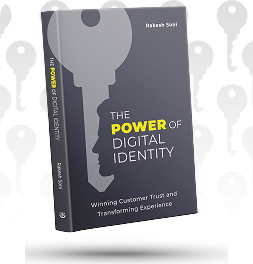
Learn How to Master Digital Trust
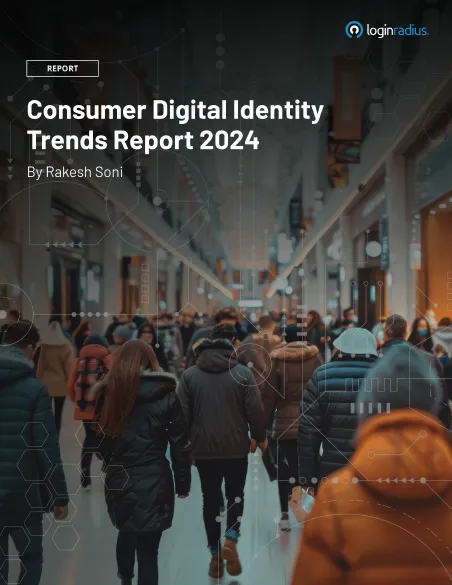
The State of Consumer Digital ID 2024

Top CIAM Platform 2024
Introduction
Imagine walking into your office building. The security guard at the gate checks your ID. You swipe a keycard to access the elevator. Once at your floor, you enter a PIN to unlock your workstation. Behind each of these steps lies a powerful yet often invisible layer of protection: access control.
In the digital world, access control works in much the same way. Every time you log into a system, open a restricted file, or attempt to use a business app, a set of rules determines whether you’re allowed in. This process is called access control in security, which is a foundational pillar that governs who can access what, when, and how.
Today’s organizations deal with an overwhelming amount of sensitive data, cloud applications, remote employees, and third-party tools. Without access control systems in place, these assets are left exposed to misuse, accidental breaches, or even malicious attacks. That’s why access control isn’t just a technical feature, it's a business necessity.
We need to remember that access control cannot be a one-size-fits-all solution. There are different types of access control models, technologies, and policies depending on your security needs, workforce structure, and compliance goals. Whether you’re an enterprise managing millions of customers logins or a startup handling sensitive customer data, understanding how access control systems work can drastically improve your security posture.
In this blog, we’ll break down what access control in security really means, how it works, the types of systems available, and best practices to implement it effectively. Whether you're new to the concept or looking to refine your current setup, this guide will help you build smarter and more secure access environments.
Why Is Access Control Important?
Access control isn’t just a security protocol - it’s the frontline defense against unauthorized access, data breaches, and internal misuse. In today’s digital-first world, where employees work remotely, businesses adopt SaaS tools rapidly, and sensitive data lives across hybrid cloud environments, it’s more important than ever to control who gets access to what—and under what conditions.
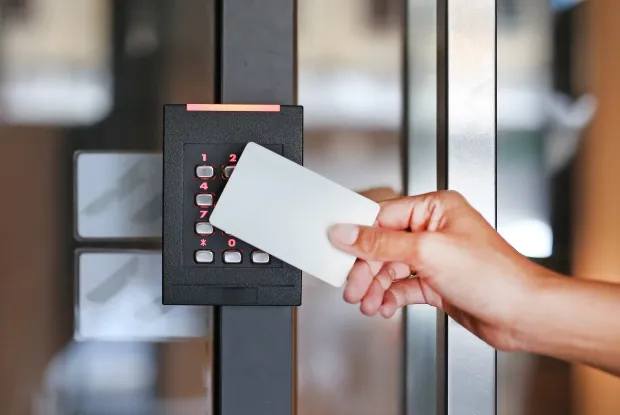
At its core, access control ensures that only the right users, devices, or systems can interact with specific data, applications, or physical resources. This becomes essential not only for cybersecurity but also for operational efficiency and regulatory compliance. A weak or outdated access control system can lead to accidental data leaks, credential theft, and insider threats—all of which can cost organizations millions in lost trust and penalties.
Access control also plays a crucial role in managing partner organizations. For instance, when a new partner organization is onboarded, their users should automatically receive access only to the resources, apps, or APIs relevant to their assigned roles—nothing more. Similarly, if a partner ends their engagement or shifts scope, their access should be instantly updated or revoked. Without a centralized B2B IAM system, businesses risk over-permissioned external users and unintended exposure to sensitive systems.
Moreover, in industries governed by strict compliance standards like HIPAA, GDPR, or PCI-DSS, maintaining robust access control policies is not optional, it's mandatory. These regulations require companies to demonstrate that sensitive data is only accessible to authorized individuals and that all access is logged, monitored, and revocable.
Simply put, access control in security is no longer a technical checkbox. It’s the backbone of zero trust architecture, where every access request must be verified, regardless of where it originates.
With modern access control solutions and access management tools, organizations can not only strengthen their defense but also streamline how users interact with systems securely.
How Access Control Works
At a glance, access control may seem like a simple yes-or-no gate. But behind that decision lies a complex and intelligent process combining identity, context, policy, and permission.
To understand how access control in security works, let’s break it into two core components: authentication and access control.
-
Authentication answers the question: Are you really who you claim to be? This is typically done using something you know (like a password), something you have (a security token), or something you are (like a fingerprint).
-
Authorization, the next step, asks: Now that we know who you are, what are you allowed to do? This involves evaluating the user’s role, device trust, location, time of access, and other contextual factors.
Once both steps are satisfied, the system either grants or denies access based on predefined access control policies.
Let’s say you’re trying to access a cloud dashboard at 2 AM from an unknown device in another country. A well-configured security access control system would detect this anomaly and either block the attempt or require step-up authentication like a one-time passcode. That’s the power of context-aware access control.
Modern access control systems go far beyond hardcoded permission sets. Today’s solutions are dynamic, integrated, and API-driven. They plug into your existing IAM platforms, HR tools, and cloud infrastructure to enforce fine-grained access decisions in real time.
Here’s what typically happens behind the scenes in an enterprise-grade access control solution:
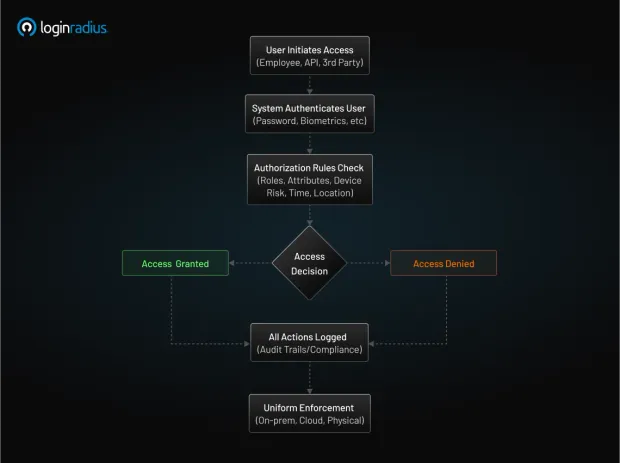
-
The user initiates access – This could be an employee logging in, an API requesting data, or a third-party vendor accessing a shared resource.
-
The system authenticates the identity – Through username/password, biometrics, or tokens.
-
Authorization rules are checked – The request is matched against your defined access control techniques and policies.
-
The system grants or denies access – Based on roles, attributes, device risk, time, location, and more.
-
All actions are logged – For audit trails and compliance.
This process happens within milliseconds but determines the safety of your entire ecosystem. With integrated access control systems, you can apply these checks uniformly across on-prem apps, cloud platforms, and even physical environments.
How to Implement Access Control
Implementing access control in security isn’t just about plugging in a tool—it’s about designing a strategic framework that aligns with your organization's structure, risk profile, and regulatory environment. Done right, access control enhances both security and usability. Done wrong, it leads to over-restriction, security gaps, or a frustrating user experience.
Here’s a step-by-step approach to implementing effective access control:
1. Define Access Control Policies Based on Business Needs
Start by identifying:
-
Who needs access (e.g., employees, vendors, customers)?
-
What do they need access to (apps, files, APIs, environments)?
-
When, where, and how they should access it (time, location, device type)?
These considerations form the basis of your access control policies. For example, your finance team may need access to accounting software only during business hours from company-issued devices, while your developers may require broader access to cloud environments.
This step is critical—without clear policies, security access control systems can’t enforce appropriate rules. Here’s how you can quickly define access control policies in the LoginRadius console:
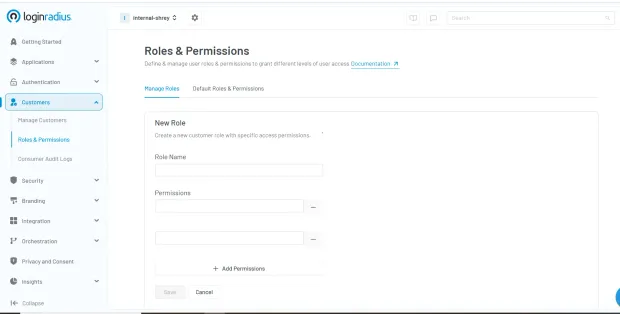
2. Choose the Right Access Control Model
There are several access control techniques you can choose from based on your organization's size and complexity:
-
Role-Based Access Control (RBAC): RBAC grants permissions based on job roles. It's easy to scale and common in enterprise environments.
-
Attribute-Based Access Control (ABAC): Makes decisions based on attributes like department, project, location, or device trust.
-
Discretionary or Mandatory Access Control (DAC/MAC): Typically used in military or high-security environments.
Some businesses benefit from a hybrid model that blends multiple techniques for more precise control.
3. Leverage Access Management Tools
Now that your policy and model are clear, the next step is implementation through reliable access management tools. These platforms allow you to:
-
Centralize access decisions
-
Automate user provisioning and de-provisioning
-
Integrate with identity providers (IdPs)
-
Set rules for employee access control, external users, or APIs
Modern access control solutions offer RESTful APIs, SAML, OAuth, and SCIM integrations—ideal for cloud-native and enterprise applications alike.
4. Use Integrated Access Control Systems
Rather than managing access in silos, aim for integrated access control systems that tie together physical access (e.g., office entry badges) with digital access (e.g., system logins). This holistic approach enhances visibility and makes compliance reporting easier.
Platforms like LoginRadius offer the ability to connect authentication and access control flows, enforce risk-based policies, and maintain consistent access logic across user types.
5. Monitor, Audit, and Evolve
Access control isn’t a “set it and forget it” task. It requires:
-
Regular audits to identify dormant accounts or over-permissioned users
-
Access reviews to verify compliance with evolving access control policies
-
Continuous improvement based on changes in your workforce, applications, or threat landscape
Investing in access logs, analytics, and alerts helps security teams proactively respond to unauthorized access attempts and policy violations.
By thoughtfully implementing access control, you're not just locking digital doors—you’re building a responsive, intelligent security access control system that evolves with your organization.
Challenges of Access Control
While access control in security is essential for protecting sensitive systems and data, its implementation and ongoing management come with a unique set of challenges. Many organizations struggle to strike the right balance between strong security enforcement and seamless user experience and that’s just the beginning.
Let’s explore some of the most common obstacles security and IT teams face when implementing and managing access control systems:
1. Over-Permissioning and Access Creep
As employees move between roles, get promoted, or switch departments, they often accumulate access privileges they no longer need. This phenomenon known as access creep is a serious risk. Without regular reviews, these over-permissioned accounts can become backdoors for insider threats or external attackers.
Robust access control policies and automated employee access control tools can help, but only if organizations enforce regular audits and cleanups.
2. Fragmented Access Across Environments
In today’s hybrid IT ecosystems, access needs to be managed across cloud platforms, SaaS tools, legacy on-prem systems, mobile apps, APIs, and even IoT devices. Without integrated access control systems, visibility and consistency become difficult to maintain.
Many organizations use separate tools for physical access, identity management, and application-level control, leading to silos that undermine security.
3. Usability vs Security
A common challenge is finding the right equilibrium: tight enough security to prevent unauthorized access, but not so rigid that it slows down legitimate users. If access controls are too complex or intrusive, employees may start circumventing them—using shadow IT tools, weak passwords, or shared logins.
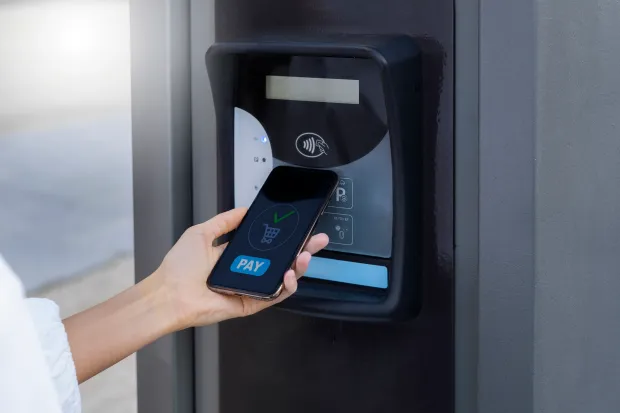
User-friendly access control solutions that incorporate contextual awareness and risk-based authentication are key to solving this tension.
4. Lack of Policy Standardization
Without well-documented and consistently applied access control techniques, different teams may set up their own rules, leading to conflicting policies and unexpected behaviors. This inconsistency not only creates confusion but can also open up security loopholes.
Having centralized access management tools ensures uniform enforcement, auditability, and compliance across departments and systems.
5. Complexity in Role and Attribute Management
While models like RBAC (Role-Based Access Control) and ABAC (Attribute-Based Access Control) offer powerful ways to define permissions, they also require deep understanding of user roles, business logic, and system dependencies. Poorly defined roles or overused attributes can quickly spiral into unmanageable complexity.
That’s why scalable security access control systems must offer intuitive role definitions, templates, and analytics to manage complexity over time.
Access control is not a one-time project—it’s a continuous journey. From shifting employee responsibilities to evolving compliance mandates and growing threat vectors, your access strategy needs to adapt. Recognizing these challenges is the first step to building a smarter, more resilient access control framework.
Different Types of Access Control
When it comes to securing digital or physical environments, no single approach fits all. Depending on your organization's needs, size, risk profile, and level of regulatory oversight, you’ll choose different access control techniques to govern user access. Understanding these models is essential to designing an efficient and secure access control system.
Let’s explore the most commonly used types of security access control models:
1. Discretionary Access Control (DAC)
In DAC, access decisions are made by the resource owner—usually the person who created the file or system. For example, a team lead might give read or write access to their project folder.
-
Pros: Flexible and easy to set up.
-
Cons: Can lead to inconsistent permissions and accidental exposure.
-
Use Case: Small teams or startups where users manage their own resources.
2. Mandatory Access Control (MAC)
MAC is the opposite of DAC. Here, access rules are enforced by a central authority based on classification levels (like Top Secret, Confidential, Public). Users can’t override these rules—even if they own the data.
-
Pros: Very secure, used in high-security environments.
-
Cons: Rigid and harder to manage at scale.
-
Use Case: Government agencies, defense, or heavily regulated industries.
3. Role-Based Access Control (RBAC)
RBAC grants access based on a user’s role within the organization. Roles (like HR Manager, Developer, Finance Analyst) come with pre-defined permissions, which makes scaling and auditing easier.
-
Pros: Scalable, auditable, and widely adopted.
-
Cons: Needs frequent updates when roles evolve.
-
Use Case: Medium to large organizations with well-defined job functions.
4. Attribute-Based Access Control (ABAC)
ABAC takes it a step further by making decisions based on user attributes, resource attributes, and environmental context. For example, a user in the “Sales” department accessing from Canada between 9–5 may be granted access.
-
Pros: Highly flexible and granular.
-
Cons: Complex to configure and maintain without a strong identity foundation.
-
Use Case: Enterprises with dynamic environments and diverse user needs.
5. Rule-Based or Policy-Based Access Control
In this approach, access is governed by defined rules or policies rather than user roles. For example, a policy might deny access to sensitive data outside business hours or trigger multi-factor authentication for high-risk actions.
-
Pros: Dynamic and responsive to context.
-
Cons: Requires a mature access management system.
-
Use Case: Organizations looking for context-aware access control or implementing Zero Trust architectures.
Each of these access control techniques has its advantages and trade-offs. Many modern access management tools and security access control systems combine multiple models (e.g., RBAC + ABAC) to deliver fine-grained, adaptive access control that meets business, user, and compliance needs.
Benefits of Access Control Systems
Whether you're protecting cloud applications, sensitive databases, or physical entry points, implementing a well-designed access control system delivers far more than just gatekeeping. It enhances security, streamlines operations, and builds digital trust across your organization.
Let’s break down the key benefits of using modern security access control systems:
1. Prevent Unauthorized Access
The most obvious benefit is also the most critical—keeping intruders out. With robust access control policies, you ensure that only authenticated and authorized users can access protected systems, files, or environments. This drastically reduces the risk of data breaches caused by stolen credentials, insider misuse, or brute-force attacks.
2. Enable Role and Attribute-Based Efficiency
With models like RBAC and ABAC, you can assign permissions based on user roles or attributes, eliminating the need to manually manage access for each individual. This simplifies employee access control and reduces the chance of human error.
- Example: When someone joins the sales team, they’re automatically given access to the CRM, sales dashboards, and email tools—without needing IT intervention.
3. Automate Provisioning and De-Provisioning
Using advanced access management tools, organizations can automate the entire access lifecycle—from onboarding to role changes to offboarding. This ensures that users don’t keep access they no longer need, which is one of the leading causes of security gaps.
- Automation also reduces IT workload and accelerates user productivity.
4. Strengthen Compliance and Auditability
Industries like finance, healthcare, and SaaS often operate under strict regulatory mandates (e.g., GDPR, HIPAA, ISO 27001). Access control solutions help maintain compliance by:
-
Enforcing least privilege access
-
Maintaining access logs for auditing
-
Generating reports for security assessments
5. Improve User Experience Without Compromising Security
Modern integrated access control systems use contextual signals (like device trust, geolocation, or access time) to adapt authentication requirements dynamically. This means users only face friction when needed, keeping the experience smooth without sacrificing protection.
6. Support Scalable Security for Hybrid and Cloud Environments
Today’s IT landscape spans on-prem apps, cloud services, and remote users. With the right access control in security architecture, you can unify access policies across platforms, ensuring consistent protection regardless of where the user or resource resides.
7. Respond Quickly to Security Incidents
Real-time monitoring and analytics provided by modern security access control systems help you detect suspicious behavior and respond before it escalates. For example, if an access attempt is made from a blocked location or an inactive account, the system can flag or block it instantly.
8. Support Zero Trust and Emerging Security Models
Modern access control systems form the foundation of Zero Trust architecture, where no user or device is inherently trusted. Advanced solutions are also beginning to incorporate AI-driven access decisions and Just-in-Time (JIT) access granting temporary permissions only when needed, and revoking them automatically after use. These trends enhance security without adding administrative burden.
By investing in the right access control solutions, organizations don’t just protect their assets—they gain operational agility, audit readiness, and peace of mind. In an era of identity-based threats and compliance pressure, access control is no longer a backend function—it’s a business-critical enabler.
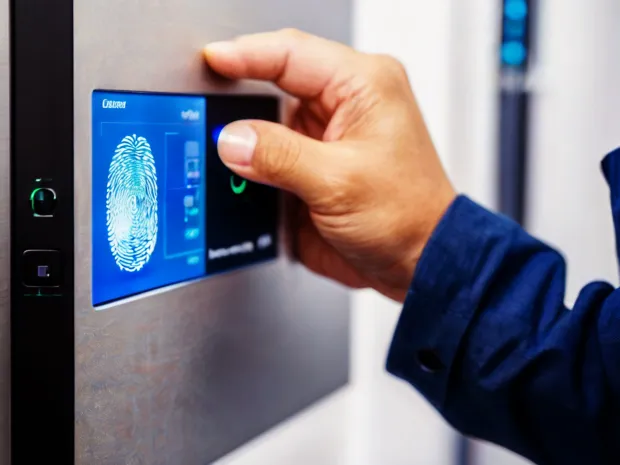
Access Control Security Best Practices
Implementing access control in security is just the beginning. To keep your systems truly secure over time, it’s essential to follow best practices that align with evolving threats, organizational changes, and compliance demands. These practices ensure your access control systems remain effective, scalable, and audit-ready.
Below are some key best practices every organization should adopt:
1. Enforce the Principle of Least Privilege (PoLP)
Always give users the minimum level of access required to perform their job nothing more, nothing less. This minimizes the potential damage if an account is compromised.
-
Regularly review user permissions to ensure no one has unnecessary access.
-
Use role-based or attribute-based access control techniques to simplify PoLP implementation across departments.
2. Conduct Regular Access Reviews and Audits
Access that made sense last year might not make sense today. Schedule periodic reviews of:
-
Employee access control lists
-
Role assignments
-
Third-party and contractor access
-
Admin privileges
This helps identify dormant accounts, privilege creep, or misconfigured access control policies.
3. Use Centralized Access Management Tools
Instead of relying on manual updates or siloed systems, use modern access management tools that centralize user permissions, automate provisioning, and integrate with your HR or identity systems.
- These tools allow consistent authentication and access control enforcement across cloud and on-prem resources.
4. Enable Context-Aware and Risk-Based Access Control
A user logging in from an unknown location or an unmanaged device should not be treated the same as someone using a trusted company laptop at headquarters.
-
Leverage integrated access control systems that adapt based on user behavior, location, device, and time of day.
-
Use adaptive MFA for high-risk scenarios without making access overly complicated. Learn more about adaptive MFA by downloading this insightful resource:
5. Log Everything and Monitor Continuously
Visibility is key. Ensure your security access control systems log every access request—successful or failed. These logs are invaluable for:
-
Detecting anomalies
-
Investigating incidents
-
Proving compliance
-
Strengthening your threat response
Bonus: Pair access logs with real-time alerting and SIEM (Security Information and Event Management) tools for proactive defense.
6. Make MFA Non-Negotiable
Multi-Factor Authentication (MFA) adds a critical second layer of verification that drastically reduces the chances of unauthorized access—especially when credentials are stolen.
-
Enforce MFA for all users accessing sensitive resources or admin dashboards.
-
Combine it with your access control solutions for seamless policy enforcement.
7. Test and Simulate Access Scenarios
Regularly test how your access control system behaves under different conditions:
-
What happens if an employee changes roles?
-
Can a terminated account still access email?
-
Are sensitive files accidentally exposed to all staff?
Simulations can uncover hidden gaps and improve both system logic and user training.
By following these best practices, organizations can build a resilient and adaptive security access control system one that evolves with business needs, regulatory standards, and cyber threats.
Conclusion
Access control is no longer just a backend IT task it’s the cornerstone of modern security strategy. Whether you’re protecting sensitive customer data, preventing internal misuse, or meeting compliance requirements, a robust and flexible access control system is critical to safeguarding your digital ecosystem.
As organizations grow more distributed and digital-first, the need for context-aware, user-friendly, and policy-driven access control solutions will only increase. The good news? With the right combination of strategy, tools, and governance, implementing effective access control policies doesn’t have to be complicated.
If you’re looking to streamline employee access control, enforce compliance, and build trust across your organization, now is the time to invest in a next-gen access management tool that supports your long-term vision for security and scalability.
Ready to take control of access? Explore how LoginRadius can help you implement secure, scalable access control tailored to your business needs. Get Started Today.
FAQs
Q. What is access control in cybersecurity?
A: Access control in cybersecurity is the process of regulating who can access digital systems, data, or resources. It ensures that only authorized users perform permitted actions based on defined security policies.
Q. Why is access control important?
A: Access control prevents unauthorized access, data breaches, and insider threats. It also helps organizations enforce compliance, protect sensitive data, and reduce operational risk.
Q. What are the main types of access control?
A: The main types include Discretionary (DAC), Mandatory (MAC), Role-Based (RBAC), Attribute-Based (ABAC), and Rule-Based access control—each varying by how permissions are assigned and enforced.
Q. What’s the difference between physical and logical access control?
A: Physical access control secures entry to buildings or rooms using locks, keycards, or biometrics. Logical access control governs access to digital systems, applications, and data using authentication and authorization protocols.

Featured Posts
Biometric Authentication Methods: How They Work & When to Use Them
Compliance Management: Processes, Systems & Best Practices
RBAC and Access Management: The Foundation of Secure IAM
How Does SAML Authentication Work?
ID Token vs. Access Token: Understand the Difference
AI-Driven Fraud Detection: The Future of Digital Trust
OIDC Authentication: How Modern Apps Verify Identity
A Complete Guide to 2FA Authentication in 2025: Methods, Risks, and Modern Best Practices
Cybersecurity Awareness Month 2025: Why Businesses Can’t Afford to Look Away
Secure Customer Experiences with Phone Authentication: Why Mobile Matters
Best Descope CIAM Alternatives in 2025
Passwordless Login: Technical Workflows, Business ROI, and Regional Adoption
Top 10 Frontegg Alternatives to Consider in 2025
Identity and Access Management in Banking: Why It’s Crucial for Security and Customer Experience
Top 10 FusionAuth Alternatives in 2025
Unlocking Secure Digital Experiences with Authorization as a Service
CIAM Platform Integrations: The Key to a Strong Customer Identity Strategy
Email is Hacked! 7 Immediate Steps to Follow
Data Governance in Healthcare: Best Practices & Future Trends
Why Social Login is a Game-Changer for eCommerce Login
Top WordPress Social Plugin Picks for Seamless Logins
Why Privacy-First Companies Choose Canada for Data Storage
Top Auth0 Alternatives for 2025: Simpler, Faster, and More Flexible CIAM Options
What Are Digital Certificates and How Do They Secure the Web
Why Hosting Your CIAM Solution in a Canadian Data Center Gives You the Edge
B2B IAM vs Workforce IAM: What Enterprises Must Know
Access Control in Security: What It Is and Why It Matters
The Making of The Power of Digital Identity: A Candid Interview with Rakesh Soni
What is Certificate-Based Authentication and Why It’s Used
6 Key Ecommerce Challenges in 2025 (And How CIAM Solves Them)
B2B vs B2C Authentication- A Quick Guide
Password Best Practices for Stronger Security
Building Community Beyond Borders: Our Thailand Story
1FA vs 2FA vs MFA: Which Method Secures You Best?
B2B IAM Best Practices and Architecture Guide
Adding Partner IAM With LoginRadius: A Complete Guide to B2B Identity Management
What is User Authentication, and Why is it Important?
What is Partner IAM / B2B IAM - A Complete Guide
Still Bending Workforce IAM for Your B2B Networks? Introducing LoginRadius Partner IAM—Built from the Ground Up
What is Biometric Authentication and How It's Changing Login
Location-Based Data Residency Boosts Trust and Conversions
The Impact of AI on Cybersecurity
PINs vs Passwords: Which is More Secure?
Why Global Businesses Trust Canada for Data Hosting Services
Passkeys vs Passwords: The Upgrade Your Security Needs
What is the Best Way to Authenticate Users?
Canada as a Global Hub for Privacy-First CIAM Platforms
How to Choose a Strong Password- A Quick Guide
A Complete Guide to Device Authentication Methods
What is a One-Time Password (OTP) ? – A Complete Guide
A Quick Guide to Username and Password Authentication
Types of Authentication and Identity Verification
What is Strong Authentication in Cybersecurity?
Top 9 User Authentication Methods to Stay Secure in 2025
Authentication vs Authorization: Key Differences, Real Examples & Best Practices
Guide to Authentication Methods & Choosing the Right One
Identification and Authentication: A Quick Comparison
Understanding Authentication, Authorization, and Encryption
Introducing the LoginRadius Trust Center: Always Up-to-Date and at Your Fingertips
What is Token Authentication and How Does It Work?
What is OTP Authentication and How Does it Work?
What is Role-Based Access Control (RBAC)?
LoginRadius Launches Next-Generation CIAM Console: Self-Serve, No-Code, and Built for Speed
Quick Guide to Single-factor, Two-factor, and Multi-factor Authentication
Democratizing Authentication: Introducing LoginRadius' Free Forever Developer Plan
Mobile Authentication: Everything You Need to Know
What is Push Notification Authentication and How It Works?
Code Less, Build More: Unveiling LoginRadius' AI-Powered Developer Documentation
Types of Multi Factor Authentication & How to Pick the Best
Risk-Based Authentication vs. MFA: Key Differences Explained
Revamped & Ready: Introducing the New Developer-First LoginRadius Website
What is SCIM? A Developer's Guide to Understanding and Using SCIM
RBAC vs ABAC: A Developer’s Guide to Choosing the Right Fit
CISOs’ Top Cybersecurity Threats 2025: Scattered Spider, Deepfakes, and More
LoginRadius 2024: A Year of CIAM Innovations
What is Passkey Authentication - A Complete Guide
How AI-Enabled Cybersecurity Solutions Are Strengthening Our Online Security
What is Identity Orchestration
LoginRadius Releases 2024 Consumer Identity Report, Highlights the Shifting Trends in Consumer Preferences
Celebrating 8th Year Milestone: How Our Collaboration with a Leading Healthcare Company Transformed Millions of Lives
Unlock Your Digital Freedom: How Automating Passwordless Authentication Can Transform Your Security
How To Secure GenAI by Implementing RBAC In The Enterprise
The Hidden Pitfalls: Why Most CIAM Systems Fail Under Pressure
No More Login Hassles: Effortless Migration to LoginRadius Awaits
How Cookie Management Supports GDPR and CCPA Compliance
LoginRadius Launches Identity Orchestration for Seamless Identity Workflows
Passkeys: Unlocking Benefits for a Better Online Shopping Experience
AI and the Changing Face of Enterprise Security Threats
Leading the Charge in Customer IAM: LoginRadius Recognized as an Overall Leader by KuppingerCole
Gearing Up for Better Customer Experiences? Choose No-Code Identity Orchestration
Announcement - LoginRadius Launches PassKeys to Redefine Authentication Security and User Experience
Decoding the Rise of Zero-Trust Adoption in Government Sector
Say Goodbye to Passwords: How Passkeys Are Reinventing Online Security
Announcement - LoginRadius Unveils the Future of Authentication with Push Notification MFA
Is Your CIAM Adapting to Global Needs? 6 Key Areas to Win Privacy-Concerned Customers
The Growing Threat of Identity-Based Attacks and the Need for an Advanced Identity Security Approach
How AI Is Changing the Game in User Authentication
eIDAS 2.0: The Digital Revolution Is Here – Is Your Business Ready to Comply?
A Quick Guide To Choosing The Right Zero Trust Vendor
Cloud Security Governance: Protecting Assets in the Digital Frontier
What is Silver SAML Vulnerability and How Can We Protect Our Digital Identities?
Identity Security for Device Trust: Navigating 2024 & Beyond
Exciting Leadership Updates Amid Strategic Growth at LoginRadius
From Past to Present: User Authentication's Evolution and Challenges
How Does Multi-Tenancy in Customer IAM Solutions Boost Security?
How No/Low Code CIAM Balances Security and User Engagement?
Beyond Passwords: Navigating Tomorrow's Authentication Landscape
How does identity management address the top 5 security challenges in B2B SaaS?
Reinforcing Security with Advanced Risk-Based Authentication in 2024 & Beyond
2FA vs MFA: Understanding the Differences
Okta Token Theft Implicated in Cloudflare's Security Breach
Voice OTP by LoginRadius: Revolutionizing Secure and Seamless User Authentication
Which is Safer: Biometric or Password?
7 Reasons to Use Biometric Authentication for Multi-Factor Authentication
Exploring Digital Identity Verification with Effective Crucial Data Checks
5 Reasons Why LoginRadius Leads the Way in the CIAM Landscape in 2024 & Beyond
Above the Horizon: Exploring the Power of a Strong Cloud Identity Platform
Streamlining Authentication: Elevate User Experience with LoginRadius AutoLookup
A Journey Through Our Top 10 Blogs from 2023
Now and Beyond- Staying Ahead with the 10 Key Cybersecurity Trends of 2024
B2B SaaS SSO Login: Exploring Enterprise Considerations in 2024
Securing Corporate Applications: A Comprehensive Guide to Enterprise Application Security
Strengthening Security Measures: The Role of Two-Factor Authentication (2FA)
Securing the Throne: Privileged Access Management (PAM) Best Practices Unveiled
7 Common Authentication Vulnerabilities to Steer Clear of
What is Identity Lifecycle Management?
Strengthening Security and Compliance: The Role of Identity Governance
Understanding the Okta Hack: Breach in Customer Support and Lessons for Organizations
Managing Generative AI Security Risks in the Enterprise- A Quick Guide
Empowering Your Security: Exploring the Advantages of Time-Based One-Time Passwords (TOTP)
The Future of Personalization: Embracing Zero-Party Data
Comprehensive Guide to Flexible CIAM Deployment Options with LoginRadius
Small Steps, Big Shields: Navigating Cybersecurity Awareness Month 2023 Safely
Streamlining Access with Converged Identity Platforms
How Retailers Can Balance Privacy While Foiling Thieves
The Power of No-code Customer IAM in Reducing Churn
CIAM: Enhancing Security & Building Consumer Trust-All At Once
Maintaining Trust: Customer Identity Verification Challenges & Best Practices
Unlocking Smartphone Security: How to Hackproof Your Smartphone
Phishing-Resistant MFA Login for Mobile Applications: Strategies and Challenges
True Passwordless Authentication: Stronger Defense Against Cyberattacks
Identity Governance vs. Identity Management: Navigating the Differences
Navigating Identity Verification Challenges in Regulated Industries: 7 Effective Solutions
Enhancing Security: Leveraging 5 Real-Time Techniques to Detect Phishing Attacks
A Comprehensive Guide to the Five A's of Cloud Identity Management
Understanding the Difference Between Identity Access Management On-Premise and Cloud
Learn the Impact of Identity Theft on Businesses in 2023
LDAP Authentication: Meaning and How it Works?
7 Things Your Security Team Need To Know Before Creating A CIAM Strategy
Choosing Between Self-Managed and Service-Based SSO Solutions: A Comprehensive Comparison
What is Cloud Identity and its Benefits?
The Legal Implications of SSO: Privacy, Security, and Compliance
Data Privacy Laws for 2023: A Closer Look at 9 Key Regulations
4 Reasons Why SSO Integrations Are a Must-Have For Online Businesses
Consumer vs. Enterprise: Navigating the Dual Nature of Digital Identity
LoginRadius Releases Consumer Identity Trend Report 2023, Highlights The Future of Customer Identity
What is a Password Vault and How Does it Work?
How a Culture of Identity Governance Empowers Digital Transformation?
Securing the Digital Frontier: The Power of AI in Next-Gen CIAM
Replatforming 101: Everything You Need to Know
Best Practices for Username and Password Authentication
The Ultimate Guide to Choosing the Right CIAM Solution
How to Use Identity Management at Every Stage of the Customer Journey?
Protecting Your Cloud Data: The Power of SaaS Security and IAM Governance
The Rise of Account Creation Fraud: What You Need to Know
Why Direct-to-Consumer (D2C) Businesses Must Take A Strategic Approach To CIAM?
What are Self-Sovereign Identities?
7 Uncommon Cyber Attacks in 2023: Why Your Organization Needs To Be Ready For The Worst-Case Scenarios
Identity Modernization: What Is It & Why Should You Care?
A Lot Can Happen In The Cloud: Multi-Cloud Environment and its Optimization Challenges
Can Security and User Experience Co-Exist in the Authenticating and Authorizing Space?
Business On The Move: How Just-in-Time Migrations Are Making Smooth CIAM Transitions
3 Digital Onboarding Trends To Watch In 2023 (And What You Can Do About It Now)
6 Tips to Prevent Accidental Data Exposure Within Your Company
Top Priorities for Customer IAM Leaders in 2023 and How to Prepare
Electronic Theatre Controls: A LoginRadius Customer Success Story
Distributed Multi-Cloud Identity Management and Its Endless Business Benefits
How The Age Of Smart Credentials Is Rewriting The Rules For Physical Verification?
Incident Response Vs. Disaster Recovery: What’s The Difference and Which Do You Need?
The Customer Experience is About to Get Even Better With Passive Authentication
What is Dynamic Authorization & Why Does it Matter?
What’s the Difference Between Attack Surface and Attack Vector?
How Identity-Based Access Ensures Robust Infrastructure Security Amidst the Growing Identity Crisis?
2FA Bypass Attacks- Everything You Should Know
IAM vs. Customer IAM: Understanding the Role of CIAM in Accelerating Business Growth
Why MFA Fatigue Attacks May Soon Be Your Worst Nightmare?
InfoSec Director, Alok Patidar Answers Your Most Difficult Questions on Cybersecurity
Understanding MITRE ATT&CK Framework?
Identity Fabric vs. Zero Trust: Is One a Better Alternative Than The Other?
The Role of Customer Identity Management in IoT Security: How It's a Must!
Securing Centralized Access Without Compromising User Experience
User Authentication in the Metaverse: What’s Changing?
LoginRadius Pledges To Raise Awareness This Cybersecurity Month
Public Cloud Risks - Is Your Organization Prepared for Cloud Threats?
What Brands Need to Know for Building the Future of Data Compliance?
Okta Identity Credentials on the Radar of Oktapus Phishing Campaign
BC Municipality Digitizes its Citizen Services. LoginRadius Brings Identity to the Table.
The Role of Customer Authentication in Paving the Way for Digital Agility
What Brands Need to Know for Building the Future of Data Compliance?
6 Alternative Authentication Methods For Your Online Customers
Implementing Zero Trust? Make Sure You're Doing It Correctly
What is Federated SSO (Single Sign-On)?
MFA Prompt Bombing: Is it a New Threat Vector to Worry About?
Privacy-Centric Enhancements: CEO Rakesh Soni Shares His Thoughts on Shifting Data Strategies
The Role of Identity Management in Securing Your Citizen’s Data
Why is Data Privacy an Immediate Enterprise Priority?
What is Out-of-Band Authentication?
How Can Enterprises Use SSO to Boost Data Collection?
Why Your Business Needs A Simple Passwordless Experience (Minus the User Friction)
Will Apple’s ‘Lockdown Mode’ Reduce State-Sponsored Attacks?
Authentication, Identity Verification, and Identification: What's the Difference
IoT Botnet Attacks: Are They the Next Big Threat to Enterprises?
Skiperformance - a LoginRadius Customer Success Story
Cross-Device Authentication and Tracking: The Opportunities and Underlying Privacy Risks
How Identity Modernization Will Thrive Business Success in 2022 and Beyond
The Pros & Cons of Reusable Digital Identity: What You Need To Know
What is Cloud Security and How it Works?
Age of No-Code Technologies: Identification and Authentication
SSO vs. Social Login: What’s the Difference? [Infographic]
Planning a Digital Makeover For Your Business? LoginRadius CIAM Can Help!
What is Cloud Computing?
Authentication vs Login - What’s the Difference?
How a Simple Password Reset Can Ruin Your Customer's Experience
GovTech is On The Rise: How Can This Technology Improve Government Services?
5 Access Management Best Practices and Benefits For Businesses
LoginRadius Releases Consumer Identity Trend Report 2022, Key Login Methods Highlighted
BITB Attacks: The New Destructive Phishing Technique
5 Reasons Why You Need to Strengthen Your Identity Authentication
What is the Difference Between MFA vs. SSO?
What is Login Authentication?
5 Ways to Improve Your Customer Verification Process
5 Myths About Phishing You Should Know
4 Common Security Issues Found In Password-Based Login
Personal Information and PII - What’s the Difference?
OTT Platforms and CIAM: How Identity Management Ensures Millions of Viewers to Scale with Ease
Is the Rise of Machine Identity Posing a Threat to Enterprise Security?
LoginRadius Integrates Search in Navigation for Better Customer Experience
5 Privacy Threats in Social Media You Should Know in 2022
Importance of Multi-factor Authentication for SSO
How LoginRadius Creates a Perfect Harmony of UX and Security
Smart Cities and Cyber Security Trends to Watch Out in 2022
Harry Rosen, a LoginRadius Customer Success Story
Top 7 Security Tips from LoginRadius’ Cybersecurity Expert to Follow in 2023
Top 7 Security Tips from LoginRadius’ Cybersecurity Expert to Follow in 2023
This Is How Scammers Get Your Email Address & How to Stop Them
Will Decentralized Auth Change the Perception of Consumer Identities in 2022?
Emerging Threat of Deepfakes: How To Identify And Prepare Against It
Everything You Need to Know Before Buying Cyber Insurance in 2022
5 Challenges for Government Adoption of Citizens’ Access Control
Are You Thinking of Token Management for Your API Product? Think about JWT!
LoginRadius Launches M2M Authorization for Seamless Business Operations
LoginRadius Offers PerfectMind Integration for a Seamless UX
Take Control of Your CIAM Environment with LoginRadius' Private Cloud
10 Tips From CIAM Experts to Reduce the Attack Surface of User Authentication
How LoginRadius Webhook Allows You to Sync Your Data in Real-Time
Federated Identity Management vs. SSO: What's The Difference?
How to Evaluate the Quality of Your User Authentication System
How LoginRadius Offers Customer-Centric Capabilities that Drive ROI
3 Best Stages of IT Security for Implementing Gartner's CARTA
How to Choose the Right User Authentication Option for your Product
An Introduction to Financial-Grade API (FAPI) for Open Banking
Why is PKI The Future of Secure Communications
How to Find the Right SSO Strategy that Fits Your Business
Cybersecurity Best Practices for Businesses in 2023 & Beyond [Infographic]
SSO Integration: How to Secure the Customer Experience on Loyalty Platforms
The Top 5 Trends in CIAM We’ve Watched in 2021
The Major Challenges of Customer Identification in the Retail Industry
Cybersecurity Awareness Month: Predicting the Deadliest Cyber Attacks in 2022
LoginRadius Delivers a Seamless User Experience that Increases Conversions through Enhanced Progressive Profiling
Avoid these Common Mistakes When Dealing with Data Breaches
Tiroler Tageszeitung (TT), a LoginRadius Customer Success Story
What are Security Keys? What are its Advantages?
Everything You Need to Know About OAuth and How it Works
Decentralized Authentication: What Is It And How It Is Changing the Industry
Getting Started with OpenID Connect
Discover the Benefits of Re-Authentication for Enhanced Security
Stand Out from the Crowd: Improve Your Customer Support with CIAM
Why Should You be Customizing Your Identity System to Your Needs
SMS Authentication — Can it Really Protect Your Business?
How Poor Login Concurrency can Impact OTT Platforms' Business
A Comprehensive Guide to Privileged Access Management (PAM)
How Cities Can Improve Civilians’ Digital Experience with Unified Identity
Refresh Tokens: When to Use Them and How They Interact with JWTs
How Progressive Disclosure Makes Your User's Onboarding Easy
What is Digital Identity Verification and Why is it Necessary?
How OTT Services can Simplify Authentication on Various Devices
A Beginner's Guide to Zero Trust Security Model
What is Identity Security?
What is a Token? What are its Pros and Cons?
How to Scale Your Business Quickly with Identity Management
How to Manage Situation After a Data Breach
How to Strike the Right Balance Between Security and Consumer Experience
How NIST is Changing Password Creation in 2021
COVID-19 and Beyond: 5 Risk Management Essentials for Your Enterprise
How WebAuth Secures Your Users’ Login
Adaptive Authentication- Is it the Next Breakthrough in Customer Authentication?
The Rise of BYOI (Bring your own Identity)
Understanding PII Compliance: A Key to Enterprise Data Security
Cyber Security Round-Up: What Happened in June 2021
How Businesses are Experiencing Digital Transformation with Consumer IAM
What is SAML SSO?
LoginRadius Offers Additional Security Layer through Newly-Enhanced Step-up Authentication Feature
Why Big Merchants Need to Deliver a Unified Consumer Experience?
All About Google One Tap Login—Explained!
What to Do if Someone Steals Your JSON Web Token?
What is Web SSO
Working With Industry Authorization: A Beginner's Guide to OAuth 2.0
Password History, Expiration, and Complexity: Explained!
SAML vs OIDC: How to Choose the Right SSO Protocol for Your Business
10 Reasons For Businesses to Implement SASE with a Zero Trust Strategy
Move beyond Traditional Risk Management with Holistic APIs
Identity Provider: What Is It And Why Should You Invest In One?
What is User Session Management?
How Entertainment Companies Use the LoginRadius CIAM platform
Consumer Data Protection: How to Handle Data Breaches in Your Business
Top 5 User Provisioning Mistakes Enterprises Should Avoid in 2021
How Secure is Two-Factor Authentication (2FA)?
The Changing Role of Identity Management in Enterprise Decision-Making
5 Reasons Why Cloud Governance Matters For Your Business
Implementing Effective Social Authentication Solution with LoginRadius
The Future of Authentication is Passwordless With Magic links
Handling Scalability and Enhancing Security with LoginRadius
Maintaining Quality Data Security Practices
Introduction to Mobile Biometric Authentication
Data Security in Hospitality: Best Practices for Operating In a Post-COVID Era
The Role of Identity management in the media industry
A Detailed Guide on How UX/UI Affects Registration
What Is a Salt and How Does It Boost Security?
Login Using Microsoft Account
A Detail Guide to Consent Management and Processing Data
Workflow Automation- What is it and Why Do You Need It?
How Companies can Enable Account security for their Consumers
What is Progressive Profiling and How it Works?
Password Spraying: What Is It And How To Prevent It?
5 Tips to Prevent OAuth Authentication Vulnerabilities
Calculating ROI, Build vs Buy (Part 1)
Identity Theft Frauds- Staying Ahead in 2021
What is privacy compliance and why is it so important?
What is Authentication? Definition and How It Works
What are Federated Identity Providers?
Login with Google Apps
What is Passwordless Login?
What is Standard Login
IoT authentication in the airline industry
Announcement - Authentication API Analytics to Evaluate the Performance of LoginRadius APIs for Your Applications
Multi-Factor Authentication - A Beginner’s Guide
Single Sign-On- A Beginner’s Guide
Top 10 Cybersecurity Predictions for 2021 That SMBs Must Know
How to Put Yourself In Control of Your Data by Leveraging LoginRadius' SSO
What Is User Management?
How CIAM Will Address The 5 Most Popular Issues In The Utility Industry
CIAM Continues to Draw Attention as Okta acquires Auth0
Protecting a Unified Cloud Platform through Cloud Security Management
What is Continuous Authentication
What is Brute Force Attack
What is Identity Authentication: How It Works and What’s Ahead
What is the Power of PIN Authentication Security?
What is Risk-Based Authentication (RBA)?
SaaS IAM for B2B: The Key to Secure, Scalable Partner Access
Understanding the Difference Between Single-Tenant and Multi-Tenant Cloud [Infographic]
What is Phone Login
Why Organizations Must Use API-Driven CIAM for Digital Agility
Why Do Consumers Prefer Social Login [Infographic]
5 Best Practices of Implementing Business Resilience during a Data Breach
What is Broken Authentication Vulnerability and How to Prevent It?
Announcement - LoginRadius Introduces Convenient and Secure Biometric Authentication for Mobile Apps
6 Strategies to Secure Your Cloud Operations Against Today's Cyber Threats
Announcement - LoginRadius Introduces Password Policy to Ensure Best Practices for Businesses and Consumers
How Is New Age Ciam Revolutionizing Consumer Experience?
What is Federated Identity Management
7 Common Web Application Security Threats
Identity Management in Cloud Computing
What is Identity and Access Management (IAM)?
Announcement - LoginRadius Announces Identity Brokering To Establish Trust Between Identity and Service Providers
5 Ways User Onboarding Software Can Revamp Your Application
How to secure an email address on your website
What is Formjacking
DNS Cache Poisoning: Why Is It Dangerous for Your Business
How to Set Up Two-factor Authentication on All Your Online Accounts?
What is Digital Transformation
The Do's and Don'ts of Choosing a Secure Password
How To Secure Your Contact Form From Bot Attacks
What is Identity Proofing and Why is it Important?
What is Identity Governance & Administration?
Announcement: LoginRadius Embraces Privacy Policy Management Amid Heightened Regulatory Updates
Login Security: 7 Best Practice to Keep Your Online Accounts Secure
9 Data Security Best Practices For your Business
How To Make Sure Your Phone Isn’t Hacked
Safe Data Act: A New Privacy Law in the Town
Email is Hacked!: 7 Immediate Steps To Follow
Announcement - LoginRadius Smart and IoT Authentication to Offer Hassle-Free Login for Input-Constrained Devices
Announcement - LoginRadius Announces Authentication and SSO for Native Mobile Apps
9 Identity and Access Management Best Practices for 2021
E-commerce Security: 5 Ways to Enhance Data Protection During the Shopping Season
Identity Management in Healthcare: Analyzing the Industry Needs
Identity Management for Developers: Why it's required more than ever
Announcement - LoginRadius Launches Passwordless Login with Magic Link or OTP, Keeps Barriers Low During Registration and Login
Announcement - LoginRadius Simplifies the Implementation of Federated SSO With Federated Identity Management
Best IDaaS Provider - Why Loginradius is Considered as the Best IDaaS Solution
Social Engineering Attacks: Prevention and Best Practices [Infographic]
Announcement – LoginRadius Announces the Availability of User Management
Consumer Identity Management for the CMO, CISO, and CIO
Announcement - LoginRadius Delivers Exceptional Authentication With The Launch Of Identity Experience Framework
Best SSO Provider: Why LoginRadius Is Considered As The Best SSO Solution
Single-Page Applications: Building A Secure Login Pathway with LoginRadius
LoginRadius Releases Consumer Digital Identity Trend Report 2020
Securing Enterprise Mobile Apps with LoginRadius
Data Governance Best Practices for Enterprises
Top 10 Benefits of Multi-Factor Authentication (MFA)
Build vs Buy: Securing Customer Identity with Loginradius
LoginRadius Identity Import Manager, An Automated Feature for Seamless Data Migration
Why Identity Management for Education Sector has Become Crucial
LoginRadius Approves Consumer Audit Trail for In-Depth Data Analysis and Risk Assessment
Online Casino and Gambling Industry Is Gaining Momentum, So Is the Cyber Threat
How LoginRadius Future-Proofs Consumer Data Privacy and Security
Authentication and Authorization Defined: What's the Difference? [Infographic]
LoginRadius Launches Consent Management to Support the EU's GDPR Compliance
Streaming Applications: How to Secure Your Customer Data
Protecting Organization From Cyber-Threats: Business at Risk During COVID-19
Announcement - LoginRadius China CIAM for Businesses to Benefit From Its Lucrative Market
Why Financial Industry Needs an Identity Management System Now More Than Ever
Announcement - LoginRadius Now Supports PIN Login with Enhanced Features
Corporate Account Takeover Attacks: Detecting and Preventing it
Marriott Data Breach 2020: 5.2 Million Guest Records Were Stolen
How LoginRadius Help Retail and E-commerce Industry to Manage Customer Identities
Announcing New Look of LoginRadius
LoginRadius Announces Its Business Continuity Plan to Fight COVID-19 Outbreak
Unlock the Future of Smart Cities
How LoginRadius Helps Enterprises Stay CCPA Compliant in 2020
Social Login Explained: How “Login with Social Media” Boosts Conversions
Identity as a Service (IDAAS): Managing Digital Identities (Updated)
The Worst Passwords of 2019
Digital Privacy: Securing Consumer Privacy with LoginRadius
One World Identity Report Names LoginRadius a Customer Identity and Access Management (CIAM) Industry Leader
Benefits of Single Sign-On: Advantages, Security, and ROI Explained
Cloud Security Challenges Today: Expert Advice on Keeping your Business Safe
The Role of Passwordless Authentication in Securing Digital Identity
LoginRadius presents at KuppingerCole Consumer Identity World
Digital Identity Management: 5 Ways to Win Customer Trust
CCPA vs GDPR: Global Compliance Guide [Infographic]
Credential Stuffing: How To Detect And Prevent It
A History of Human Identity in Pictures Part 3
A History of Human Identity in Pictures Part 2
A History of Human Identity in Pictures - Part 1
What is Multi Factor Authentication (MFA) and How does it Work?
Why LoginRadius is the Best Akamai Identity Cloud (Janrain) Alternative
5 Reasons To Know Why B2C Enterprises Should Use Single Sign-On
8 Key Components of a Perfect CIAM Platform
What is Customer Identity and Access Management(CIAM)?
What is Single Sign-On (SSO) and How it Works?
California's CCPA 2.0 Passed: Everything You Need to Know About the New CPRA
IAM vs. CIAM: Which Solution is Right For You?
Looking for a Gigya Alternative? Try LoginRadius, a Superior and Modern Identity Platform
Presenting: Progressive Profiling from LoginRadius
Best Practices for Choosing Good Security Questions
How Do I Know If My Email Has Been Leaked in a Data Breach?
The Death of Passwords [Infographic]
How to Use Multi-Factor Authentication When You Don’t Have Cell Phone Access
The Customer Identity Infrastructure that Cruise Line Passengers Don’t See
Why Your Enterprise Needs a Digital Business Transformation Strategy
Reconsidering Social Login from a Security and Privacy Angle
Improving Customer Experience in the Public Sector
Customer Spotlight - Hydro Ottawa
Digital Transformation: Safeguarding the Customer Experience
Rede Gazeta, a LoginRadius Customer Success Story
4 Barriers to Building a Digital Business and How to Overcome Them
LoginRadius Announces $17M Series A Funding from ForgePoint and Microsoft
BroadcastMed, a LoginRadius Customer Success Story
Why Municipalities Are Investing in Citizen Engagement
Customer Experience is Driving Digital Transformation
Identity Fraud Hits All-Time High in 2017
Phishing Attacks: How to Identify & Avoid Phishing Scams
IFMA, a LoginRadius Customer Success Story
Canada To Fine Companies For Not Reporting Data Breaches
Mapegy, a LoginRadius Customer Success Story
Aurora WDC, a LoginRadius Customer Success Story
IOM X, a LoginRadius Customer Success Story
Customer Identity Preference Trends Q2 2016
Customer Identity Preference Trends Q1 2016

